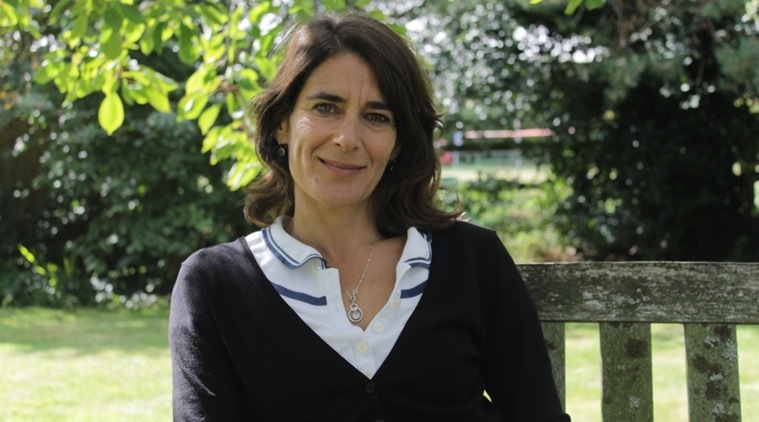The long way home
British writer Esther Freud on her unconventional childhood and mining her personal history for her novels.
 A rich autobiographical thread runs through Esther Freud’s novels.
A rich autobiographical thread runs through Esther Freud’s novels.
For a very long time in her childhood, the ground beneath Esther Freud’s feet was never still. Home was an endless journey from one rented apartment to the next, from one new adventure onto the next great unknown. The landscape changed often — from the placidity of the British countryside in Sussex to the rainsoaked shores of Ireland and the souks of Marrakesh in Morocco, where she found herself with her mother and sister when she was four and where she lived for the next 18 months. It stoked her curiosity about the glorious, uncertain universe she found herself in, a world which never allowed her to be still. “In order to make sense of the many changes and upheavals, I was always making up stories. It was a useful background for a writer as it turned out, and has given me a lot of material,” says Freud, 52, author of novels such as Hideous Kinky (1992), The Sea House (2003), Lucky Break (2010) and last year’s standout novel, Mr Mac and Me.
On a sun-soaked afternoon at the recently-concluded Zee Jaipur Literature Festival, seated on the press terrace, Freud spoke about how she found her way into writing. As the younger daughter of Jewish painter Lucian Freud, one of Britain’s foremost artists of all time, and the bohemian Bernadine Coverley, whom he immortalised in the portrait titled Pregnant Girl (set to go under the hammer at Sotheby’s contemporary art evening auction in London on February 10), Freud’s unconventional childhood had never been short of stories. Her grandfather, the renowned architect Ernst Freud had moved to England in 1933 with his family to avoid Nazi persecution. Freud’s parents separated soon after her birth, even though they remained friends. Coverley, who had had both her daughters before she turned 20 chose to make a life for herself and her daughters on her own. “My father’s Jewish, my mother Irish and they both sort of had to make new lives for themselves and there’s a toughness that comes from that, there’s a kind of grit about starting again, recreating yourself,” she says.
In this peripatetic life, there were only two constants — art and literature. Freud spent hours watching her father paint and then later, sitting for him. “My father’s work ethic was incredible, while my mother lived her life in a very creative way, making her homes and her gardens beautiful, travelling, dancing, reading,” she says. It was Coverley who introduced her to books. “I was slow to learn to read, but my mother always read to us every night. She read The Arabian Nights, The Hobbit. She tended to read big sagas and I loved to hear her reading,” she says. Freud’s own use of language is cadenced, rich in its simplicity. “I always read out what I write. It’s important that it sounds believable,” she says.
A rich autobiographical thread runs through her work. In Hideous Kinky, her debut novel, shortlisted for the John Llewellyn Rhys Memorial Prize and made into a film starring Kate Winslet, she turned her memories — “material that would not cover more than 10 pages” — into a young mother’s attempts to integrate herself and her children into a foreign culture. In The Sea House, she takes off from the letters her grandfather Ernst Freud wrote to his wife. Mr Mac and Me is based on the time spent by architect and painter Charles Rennie Mackintosh in Suffolk during World War I, a village where she owns a family home.
Her great grand-father, the neurologist and psychoanalyst Sigmund Freud, would have probably found it of interest that there’s always a bit of Freud in her works, but the writer dismisses it as nothing beyond authorial appropriation. “I feel I need to own the story in some way. Sometimes, I have an idea for a story and it takes me some time to uncover how I can link myself to it. As I have grown more confident as a writer I have needed this less, and the links have become more tenuous, but they are still important,” she says.
Rather early in life, Freud knew she wanted to be more, without quite knowing what. “I was looking for something to do with my life right from the start and aged about 12, I hit upon acting,” she says. From when she was 16 till she turned 20, Freud attended acting schools in London. In 1981, she met Kitty Aldridge at the Drama Centre in London, and the two went on to write their own show titled The Norfolk Broads that did rather well in its time. “While I was working as an actress, I started writing, just for my own pleasure, and found that it was then I was at my happiest. Slowly, writing took over from acting, and by the time I’d written my second book, I knew I’d never go back. Why have a small part in a play, when I could be the creator of every part in a book?” she says.
Freud writes every morning, working her way through drafts, till she arrives at the heart of the novel. “I don’t have a vision to stay true to — just a few tantalising glimpses that lure me on. I do many drafts as I find my way into the story. Very occasionally, I’ve a clear idea of the form the story will take, but, in most cases, I’ve been surprised by what I find inside myself,” she says.
If there has been any longing that she has harboured, it is to belong. Her parents had decided early on that they didn’t want anything to do with their families. “So I was brought up almost like a child in time. I had no relatives that I knew, certainly none nearby. I wrote two novels about my Jewish ancestry, because I needed to feel like I belonged to a larger family. I think every generation rebels. My grandfather apparently was family-minded, more sentimental, liked having his family around, whereas my father didn’t want anything to do with it. I love my family. I can’t have enough of them. So I kind of rebelled in the only way I knew I could — by being really sentimental,” she says.
Her next work, after Mr Mac and Me, is a play about male prisoners learning embroidery, a project she has been planning for a long time. But there’s something else that has been on her mind since her parents passed away in 2011. “I have thought about writing a book about my parents, who, although 20 years apart in age, died in the same week. I like the idea that, after having been separated for 48 years — since I was born — they were reunited in this powerful way. I have a title for it, but so far, not very much else,” she says.





- 01
- 02
- 03
- 04
- 05






















